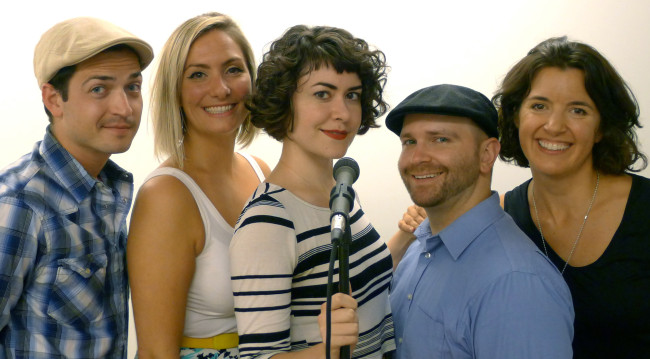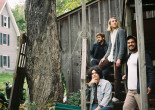Each ‘Knock on the Door’ reveals a new story in improvised podcast drama at Scranton Fringe Fest

Shows run tonight through Sunday at Coalwork
“A Knock on the Door” will be performed three times during the Scranton Fringe Festival this weekend, yet it will never be the same show twice.
That’s because audience suggestions will influence three actors and one sound effects artist to follow a unique creative path every time, crafting an improvised narrative that will be recorded for a podcast at Coalwork (544 Spruce St., Scranton) on Friday, Oct. 2 at 9 p.m.; Saturday, Oct. 3 at 2 p.m.; and Sunday, Oct. 4 at 4:30 p.m.
NEPA Scene talked in-depth with actor and writer Tara Gadomski about the live audio drama and returning to her hometown of Scranton from New York for these special performances.
NEPA SCENE: Tell us what “A Knock on the Door” is about and give us some background about yourself.
TARA GADOMSKI: I have a strong background in improvisation and radio. I did dramatic improv for many years in London with a company called Fluxx.
What I really love doing is doing full plays improvised. They end up being comedy, sometimes they end up being drama, romantic comedies, or thrillers, depending how it goes with the audience’s suggestions. I also have a strong background in radio production, radio news, radio features. For 15 years, I freelanced with the BBC in between acting gigs.
I love radio drama. BBC drama is a strong art form, full length plays. Every day there are several on the BBC. I started getting involved in that in the U.K. for an independent smaller production. Then I started here in the my own podcast for radio drama called Geste that I and other actors I know write and produce plays, we act in them, and I record and edit them.
I had this bubbling in the back of my brain for a year now for radio drama. Is there anyone out there doing improvised radio drama? I couldn’t find anyone that was doing it in long form. I came up with this idea of how it would work with live audiences. There are a couple of key elements. There are three actors and one Foley artist, who does sound effects. This specific idea has never been done anywhere else.
I am grateful for the Scranton Fringe Festival to be able to take a risk. So, basically how it works is that we’ve been working on this and we’ve been working on improvising together. Our director acts as our audience in Scranton and throws us ideas. We are going to ask the audience a couple questions to get us started. They still have the chance to cast the play, so who the people are in relation to each other, to the actors, could be anything, so you could be going into territory you don’t know. Some days, two of us could be married, brother and sister – you never know.
We ask some words to get us started. Because we have the special elements of the sound effects, we are going to ask for a couple of donated props just for the show to have us make extra sound effects. The coolest thing about our Foley artist, Robert Gonyo – who is so key to this piece that I can’t express that enough – he’s an actor, director, and musician. He has this little suitcase that has a couple things like a bag of rice, drumstick – he can do anything. As the play goes on, as we’ve been doing it in rehearsal, all of the sudden, we will take a turn where the scene is in the men’s room and all of the sudden he could do the sound of being in a men’s room.
The audience is the fifth element; we have the three actors, the Foley actor, and the audience as the fifth character because they are giving us suggestions. We are doing it live in front of them like the old days with radio programs. We have a football game and the audience could be our cheering crowd. We could have a sign to put up, like “welcome to cheer or sing.”
NS: The nature of it is that it will be forever changing.
TG: Exactly. It will be a brand new play every single time. What the audience is made up of is like a social experiment. The audience on a Friday night would be different than an audience at 2 p.m. on a Saturday. We are rated PG-13, but we could change based upon the audience. It is the audience helping us writing the play, so we’re all into it together. For us, as actors, it’s really exciting for us to do the long form dramatic improv because you are creating this character and scene, and we are writing this play together and sometimes something will come out from deep inside you.
NS: So how do you prepare for something like this?
TG: That’s a great question, and it’s always the question with improv. The main thing is getting to be able to work with the Foley artist a lot, getting to know each other’s rhythms, almost like a musical band, and also push each other. We all worked together before, but in separate capacities. We’ve never worked together as one big group; we rehearsed in Europe. We’ve been doing improv and exercises which are standard, getting us loosened up and working with each other. We started doing longer themes and pushing characters for each other too, which I think has been key and has been interesting.
The other part of this whole thing is when you see an improvised theater play, because you are watching people, they are the same characters, but sometimes we will play more than one character in the play because it’s our voices and we are all skilled in dialects and accents. In practice, we’ve been pushing each other in playing different characters and scenes. We’ve been doing trial runs with our director, who acts as our audience and gives us ideas. We did about seven or so trial runs, and they’ve become deeper. We wanted to see what happens and push the characters, roles, events happening further.
To give an example, at rehearsal, we did two trial runs. The first play ended up being about a couple, and out of nowhere, another woman appeared who was a long-lost daughter that the other woman gave up for adoption. Then it became a dark play because the woman didn’t want the daughter she gave up for adoption; they turned and broke up, so that ended up being a deep relationship drama. The next drama we did was the same actors, different set of casting; if the audience cast us this way and threw in different words, all of the sudden we did a play about a man who was trying to get away from his divorced wife who was then stalking him. The day before, we did the trial run, which ended up a comedy with a woman who was a huge collector of McDonald’s memorabilia and Grimace came to life in her apartment. The same actors, nothing different but the audience – we just go with twists and turns, and the audience is the huge part of it.
NS: On that note, is it possible to predict what an audience might do?
TG: There isn’t really a prediction; it could be a comedy, drama, or thriller. The idea of the sound effects and donated props from the audience is that we are trying to use them right away, whatever they have with them.
NS: So if we gave you a pen right now…
TG: You wouldn’t believe what a Foley artist could do with that pen. He could make all kinds of sounds that are not a pen. One time in rehearsal, we had a packet of gum, and it became a crackling fire – plastic amplified against the microphone became a fireplace. That’s what we are doing because the fact that it is words and imagination. We are recording all of them and putting them on my podcast, which will be on iTunes later in the month. The point is to record it so it lasts beyond that first night. It is writing a play on the night that is going to endure on the Internet for eternity. I’d like to say to the audience that participation is completely voluntary.
NS: How long are your plays?
TG: We will have an introduction, where our emcee will get suggestions from the audience. Once we get started, from that point on, the plays last about a half hour. The one thing we know that everything contains is a knock on the door; that’s why it’s called “A Knock on the Door.” It’s a nod to the idea that in the old time radio, there’s always a knock, knock, knock on the door, which was the turning point. Every play has a knock on the door, so that is our one anchor, that we always have a knock on the door. Who is going to do it, and when? I’m not sure.
I’m originally from the area; I grew up in Wayne County and was born in Scranton. When I heard about the Fringe Festival from a friend in Scranton… it’s hard to take a risk in New York City sometimes, cost of space, but the second part of it is Scranton is known for this back in the vaudeville days – if you could get to a Scranton audience, you could get anywhere. Scranton audiences are known for being good, but tough audiences.
The Fringe Festival has been so supportive, and we are doing it at Coalwork, which is a great space on Spruce Street. We are going to set up our microphone in the window seat, so from outside, it will look like a little recording studio. For the time we will be in there, it will be a studio, recording. I’m so happy we were put in this space instead of a theater. It’s an open workspace, which is exactly what we’re doing, and an open plan, working together.
What I’d like to, after Scranton, is to take it all over the place. Once I can say this worked at Scranton in the Fringe Festival, I can take it all over the world. What is so exciting is it will be different. So let’s say I take it back to London – how would that be a completely different show because of the audience, different from Scranton or New York? It’s a social experiment in a way. It’s exciting to do it and get the stamp of approval in Scranton.
NS: We’re excited to be a part of the audience.
TG: Thank you. I really like that it’s not just a comedy, though sometimes dramas or thrillers have an undercurrent of dark comedy.
NS: Is there anything else you’d like to add?
TG: As a bit of a shout out, which should be in the press release, but our Foley artist, Robert Gonyo, is instrumental to the show, as well as our director, Laura Hooper, who is from the U.K. and has a long background in improv theater and site-specific theater. She knows how to do a piece of improv theater in a space. And the two other actors who are working with me. Nick Fondulis, he had a role on “30 Rock” – he was a nemesis to one of the characters on “30 Rock.” He’s so funny, and it’s been great to get the other side of him. Caitlin Johnston has a great dramatic, tough side – she played on “The Knick,” which is a drama, and I’ve been in a lot of dramas with her, so it’s great to see her comedic side.
We are all experienced with scripted material, so it’s freeing to work in this environment of improv. We are priming those characters, goals, and actions in the moment. It gets real. I looked over at Nick when we were rehearsing in the middle of one of the plays about the divorced couple and he had tears in his eyes and it was getting real, and it’s coming from somewhere deep inside of us; it’s beautiful. It’s not a breakdown, but it’s coming from somewhere deep.
NS: The fact that it’s so sudden, thrust upon you, you don’t have time to prepare to act a certain way or think about it. Here it is.
TG: That’s the key. That’s what we strive for when we do scripted material; we strive for being so in the moment, yet we know in the back of our head what to expect because there’s a script and there are technical people telling you what spot to move next and don’t you mess up the lighting, so in the back of your head you’re thinking, “I have to get here, I have to get there,” but in long form improv, you are right there. Whatever happens next happens next, and everyone has to go with you. It’s a great experience as an actor.
NS: Any final thoughts?
TG: I am grateful to the Fringe Festival. They organized it so well. I performed at Edinburgh, the mother of all fringe festivals, in Scotland. I appreciate how Scranton is so one-on-one that you can get with the organizers; it’s very supportive, and they took on this task that’s really exciting, what they’re doing for the area. I know the actors that are not from the area, from New York, are really excited. A lot of people know Scranton from “The Office,” of course. I’ve been saying, “Wait until you guys see what Scranton is about. You’re going to see shows being performed right off the square.” It’s so beautiful, right there on the square, so they’re excited to see Scranton and get to know what it’s about.
Location: Coalwork (544 Spruce St., Scranton)
Dates/Times: Friday, Oct. 2 at 9 p.m.; Saturday, Oct. 3 at 2 p.m.; and Sunday, Oct. 4 at 4:30 p.m.
Cost: $10, $7 with Fringe Fest button



